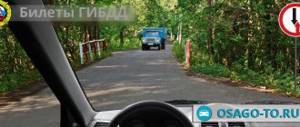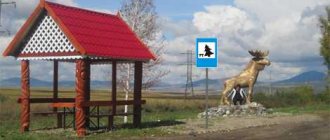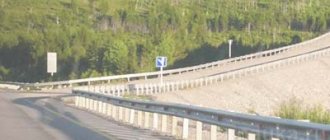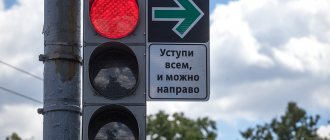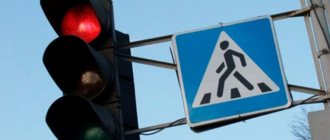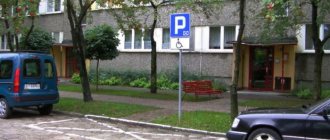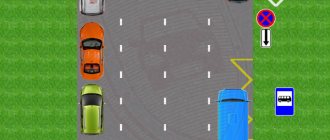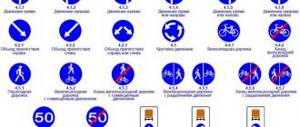Have questions? Get advice from a car lawyer:
8 (800) 350-29-83 — Regions of Russia 8 Moscow and Moscow region. 8 St. Petersburg and Len. region
It's fast and free!
The times when you could park your car almost anywhere in a populated area are long gone. Now cities have clearly defined places where you can stop and/or stand, and where this is strictly prohibited. To ensure that drivers are informed in advance about entering a certain zone and parking regulations, the traffic rules have approved special signs and plates for parking.
What does the traffic rules say?
The basic law for every car enthusiast is a small blue book, studied in driving courses - traffic rules. This set of rules thoroughly defines which actions of road users are permissible, which are undesirable, and which are strictly prohibited. In relation to vehicle parking, the following mandatory requirements have been established:
- Cars park on the right side of the road on the side of the road. If it is not there and the car can be parked so that it does not interfere with traffic, parking directly on the road surface is allowed.
- The “Parking Zone” sign is installed in populated areas in places where it is permitted. The main image (the Latin letter P on a blue background) can be supplemented with various symbols (arrows, numbers, etc.) or inscriptions. This is necessary to clarify parking rules and clarify other important points.
- It is prohibited to stop and stand in places specified in the traffic rules (on bridges, in tunnels, at crosswalks, etc.).
- Long stops for the purpose of spending the night or rest outside populated areas are permitted only at specially equipped sites, etc.
Important! Drivers do not need to know the rules of the road by heart, but road signs and markings help them navigate the roads and cities and avoid committing offenses.
Appendix 1: Additional information signs (plates)
Road signs (according to GOST R 52289-2004 and GOST R 52290-2004)
Additional information signs (plates) clarify or limit the effect of the signs with which they are used.
8.1.1 “Distance to object” The distance from the sign to the beginning of the dangerous section, the place where the corresponding restriction is introduced, or a specific object (place) located ahead in the direction of travel is indicated.
8.1.2 “Distance to object” Indicates the distance from sign 2.4 to the intersection if sign 2.5 is installed immediately before the intersection.
8.1.3 “Distance to object” Indicates the distance to an object located to the side of the road.
8.1.4 “Distance to object” Indicates the distance to an object located to the side of the road.
8.2.1 “Validity area” Indicates the length of the dangerous section of the road indicated by warning signs, or the coverage area of prohibitory and information signs.
8.2.2 “Validity area” Indicates the coverage area of prohibitory signs 3.27 - 3.30.
8.2.3 “Validity area” Indicates the end of the coverage area of signs 3.27 - 3.30.
8.2.4 “Validity area” Informs drivers that they are in the coverage area of signs 3.27 - 3.30.
8.2.5 “Validity zone” Indicate the direction and coverage area of signs 3.27 - 3.30 when stopping or parking is prohibited along one side of the square, the facade of a building, etc.
8.2.6 “Validity zone” Indicate the direction and coverage area of signs 3.27 - 3.30 when stopping or parking is prohibited along one side of the square, the facade of a building, etc.
8.3.1.-8.3.3 “Directions of action” Indicate the directions of action of signs installed in front of the intersection or the direction of movement to designated objects located directly next to the road.
8.4.1.-8.4.8 “Type of vehicle” Indicate the type of vehicle to which the sign applies. Plate 8.4.1 applies the sign to trucks, including those with a trailer, with a permissible maximum weight of more than 3.5 tons, plate 8.4.3 – to passenger cars, as well as trucks with a permissible maximum weight of up to 3.5 tons , plate 8.4.8 - for vehicles equipped with identification marks “Dangerous Goods”.
8.5.1 “Saturdays, Sundays and holidays” Indicate the days of the week during which the sign is valid.
8.5.2 “Working days” Indicate the days of the week during which the sign is valid.
8.5.3 “Days of the week” Indicate the days of the week during which the sign is valid.
8.5.4 “Validity time” Indicates the time of day during which the sign is valid.
8.5.5 “Validity time” Indicate the days of the week and time of day during which the sign is valid.
8.5.6 “Validity time” Indicate the days of the week and time of day during which the sign is valid.
8.5.7 “Validity time” Indicate the days of the week and time of day during which the sign is valid.
8.6.1.-8.6.9 “Method of parking a vehicle” 8.6.1 indicates that all vehicles must be parked parallel to the edge of the roadway; 8.6.2 – 8.6.9 indicate the method of parking cars and motorcycles in a sidewalk parking lot.
8.7 “Parking with the engine not running” Indicates that in the parking lot marked with sign 6.4, parking of vehicles only with the engine not running is permitted.
8.8 “Paid services” Indicates that services are provided for cash only.
8.9 “Parking duration limit” Indicates the maximum duration of a vehicle’s stay in a parking lot indicated by sign 6.4.
8.9.1 “Parking only for holders of parking permits” Indicates that only vehicles whose owners have a parking permit, obtained in accordance with the procedure established by the executive authorities of a constituent entity of the Russian Federation or local self-government bodies and valid within the territory whose boundaries are established by the relevant executive authorities of the constituent entity of the Russian Federation or local government bodies.
; ;
8.10 “Place for inspection of vehicles” Indicates that on the site marked with sign 6.4 or 7.11 there is an overpass or inspection ditch.
8.11 “Limitation of permissible maximum weight” Indicates that the sign applies only to vehicles with a permissible maximum weight greater than that indicated on the plate.
8.12 “Dangerous shoulder” Warns that going onto the side of the road is dangerous due to repair work being carried out on it. Used with sign 1.25.
8.13 “Main Road Direction” Indicates the direction of the main road at the intersection.
8.14 "Traffic Lane" Indicates the traffic lane or bicycle lane covered by a sign or traffic light.
8.15 “Blind pedestrians” Indicates that the pedestrian crossing is used by blind people. Used with signs 1.22, 5.19.1, 5.19.2 and traffic lights.
8.16 “Wet surface” Indicates that the sign applies to the period of time when the roadway surface is wet.
8.17 “Disabled Persons” Indicates that the effect of sign 6.4 applies only to motorized wheelchairs and cars on which the “Disabled Person” identification marks are installed.
8.18 “Except for disabled people” Indicates that the signs do not apply to motorized wheelchairs and cars on which the “Disabled person” identification signs are installed.
8.19 “Class of dangerous goods” Indicates the number of the class (classes) of dangerous goods according to GOST 19433-88.
8.20.1.-8.20.2 “Vehicle bogie type” Used with sign 3.12. Indicate the number of adjacent axles of the vehicle, for each of which the mass indicated on the sign is the maximum permissible.
8.21.1.-8.21.3 “Type of route vehicle” Used with sign 6.4. They indicate where vehicles are parked at metro stations, bus (trolleybus) or tram stops, where transfer to the appropriate mode of transport is possible.
8.22.1.-8.22.3 “Obstacle” Indicate the obstacle and the direction to avoid it. Used with signs 4.2.1 - 4.2.3.
8.23 “Photo and video recording” Used with signs 1.1, 1.2, 1.8, 1.22, 3.1 – 3.7, 3.18.1, 3.18.2, 3.19, 3.20, 3.22, 3.24, 3.27 – 3.30, 5.14, 5.21 , 5.27 and 5.31, as well as with traffic lights . Indicates that in the coverage area of a road sign or on a given section of the road, administrative offenses can be recorded using automatic special technical means that have the functions of photography, filming and video recording, or by means of photography, filming and video recording.
8.24 “A tow truck is working” Indicates that a vehicle is being detained in the coverage area of road signs 3.27 - 3.30.
8.25. “Ecological class of the vehicle”Plates are placed directly under the sign with which they are used. Plates 8.2.2—8.2.4, 8.13, when signs are located above the roadway, shoulder or sidewalk, are placed on the side of the sign. In cases where the meanings of temporary road signs (on a portable stand) and stationary signs contradict each other, drivers must be guided by the temporary signs.
Note
Signs in accordance with GOST 10807-78 that are in use are valid until they are replaced in the prescribed manner with signs in accordance with GOST R 52290-2004.
Penalties
If a car owner does not comply with the instructions of parking signs with plates, photos of which are shown to every beginner even at the stage of driver training, he will face serious fines. The list of the most common parking violations includes:
- placing the vehicle in the second row;
- failure to comply with markings or special signs;
- parking in an unauthorized place (for example, in an area for the disabled or in an area where drivers are prohibited from standing and stopping), etc.
Plates installed together with special signs allow drivers to be more accurately informed about the requirements, restrictions or prohibitions in force in populated areas.
8.6.1 “Method of parking a vehicle”
June 15, 2015 Administrator Home page » Road signs Views:
One of the serious problems of modern megacities is the implementation of vehicle parking.
It often happens that drivers leave their cars where they see fit.
And even in those places where parking is strictly prohibited by the sign of the same name - “Parking is prohibited” (3.28). But, you must admit, this sign does not solve the problem of lack of parking spaces.
At the same time, very often there is a need to indicate to vehicle drivers how to park: how to park their car on those sections of the road that directly border the sidewalk.
It is to achieve this goal that a large family of signs “Method of parking a vehicle” is provided, which are used with only one sign - “Parking (parking space)” (6.4).
Let's try to figure it out. All nine signs provide comprehensive information on how to park a vehicle using the sidewalk and sidewalk space.
This can be done parallel to the roadway or at an angle to it; with partial, full access to the sidewalk or without using the sidewalk at all.
However, the driver must remember: it is necessary to strictly comply with the requirements of the sign - the car should be parked exclusively in the specified way. Otherwise, he will grossly violate the Rules.
Let's look at a specific example.
Analysis of the road situation presented in the figure allows us to conclude that parking in this area is permitted only at an angle to the roadway and only with the front part of the car facing the sidewalk.
As you can see, the driver of car A correctly implemented this requirement. But car B is parking parallel to the roadway. This means that the driver of this vehicle violated the parking rules.
And here it is necessary to make one very important remark. The information sign “Parking (parking space)” (6.4) in combination with one of the signs “Method of parking a vehicle” indicates exactly the METHOD OF PARKING, but not stopping.
Therefore, if the driver of car B makes a stop, then he does not violate the requirements of these signs that regulate parking.
And now a few words about plate 8.6.1.
As can be seen from the image on this plate, the vehicle must be parked parallel to the roadway without using sidewalk space. According to section 12 of the traffic rules, this is the classic way to park a vehicle.
That is why all vehicles - motorcycles, cars and trucks, tractors and horse-drawn carts - can be parked using the method indicated on the sign. Moreover, cars can be with or without trailers.
Summarize. Sign 8.6.1 “Method of parking a vehicle”, installed in combination with the sign “Parking (parking space)”, informs drivers that all vehicles must be parked in the manner indicated on the sign - parallel to the roadway and along the sidewalk .
If this information was useful to you, please write about it in the comments. If you have any questions, write, I will definitely try to help you.
Traffic regulations online from the autoass team!
The content of the article:
- sign 8 6 1
- method of parking a vehicle
- plate 8 6 1
- 8 6 1
Tags: method of parking a vehicle
